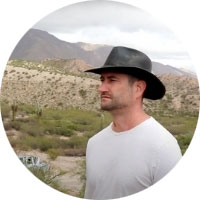Get Easy Health Digest™ in your inbox and don’t miss a thing when you subscribe today. Plus, get the free bonus report, Mother Nature’s Tips, Tricks and Remedies for Cholesterol, Blood Pressure & Blood Sugar as my way of saying welcome to the community!
Can these extreme-altitude wines reverse aging?

Do you know what’s in that wine bottle sitting on your kitchen counter?
…try “oak” flavoring… “Mega Purple” dye and TONs of sugar (added because mass-market winemakers often pick their grapes before they mature and then cleverly try to hide it)…
… and that’s not counting all the chemicals left over from vineyards that look more like oil refineries than the great Chateau of old… (for example, a study in California found herbicide in every single bottle tested!)
But better wines do exist… and they don’t cost an arm and a leg either…
…like the wine I am about to describe to you today… made from handpicked grapes fed with natural snowmelt water that trickles down from mountain peaks 10,000 feet high…
…from old vines brought from France over 100 years ago (vines that don’t even exist in Europe anymore!)… no dyes… no filter… a color so deep and dark they call it “black wine”
Problem is… this delicious red wine (with hints of balsamic, leather, and black berry) can only be found in a single isolated corridor of the Southern Hemisphere, in a remote desert valley at the foot of the Andes Mountains — “the world’s most isolated wine region” — at an altitude most grapes could barely survive…

It’s known as the Gualfin region (and more specifically, the Calchaqui Valley).
With wild temperature swings (as much as 70 F)… powerful blasts of UV light through the thin atmosphere (80% more intense than Bordeaux)… low oxygen levels and roaring winds…
It’s enough to kill most things.
But for those plants and animals that survive, the “test” comes with major benefits: longevity and good health.
Gualfin’s inhabitants are a small group of homesteaders and natives. They live in near total isolation.
Up at the most remote vineyard — almost impossible to harvest — an elderly woman, Elena, lived in complete self-sufficiency well into her 80s.
(She made — and I can attest to this personally — the best cheese in the valley.)
She had no daily pill regimen (The nearest pharmacy is a day’s journey) and she rarely saw a doctor. Around these parts, if you fall ill, the trek to see a doctor is more dangerous than toughing it out on your own.
In any case, the people here seem to stay active and live far beyond what their rough-hewn lives might dictate.
Longer Life… Less Disease
For scientists, the latter observation would scarcely be surprising. “That which does not kill you…” is actually a scientific fact.
Stressing yeast with short bursts of extreme heat and cold allows them to live up to 30% longer. And studies have linked “caloric stressing” — aka fasting — leads to longer lifespans and less disease.
Of course, we aren’t all going to pack up and move to the edge of civilization to battle it out against the elements. But that’s where wine comes in…
At over 8,400 feet above sea level, in the most extreme growing conditions on earth, Malbec grape vines growing in the Calchaqui Valley adopt some unusual characteristics.
They become ultra-efficient at concentrating the few nutrients they have and they become ultra-resilient against potential bugs and threats. They say there are vines around that must be more than one hundred years old…
I believe it because I’ve seen it.
And the benefits of this struggle against nature don’t just stay in the plant.
They carry on through to the wine… and the wine drinker.
You Can ‘Inherit’ Longevity through Wine
It’s a myth that red wine is good for your health because it contains antioxidants.
The real health benefit of red wine comes from a part of the vine known as the “sirtuin pathway.”
It’s a pathway that springs to life when the vine comes under stress.
The extreme-altitude vineyards of the Calchaquí Valley — faced with low O2, high UV, and sudden temperature swings — cling to the edge of survival.

They survive because sirtuin activation floods the grapes and their skins with a plant chemical known as a flavonoid. This thickens and darkens the skins to protect the grape. You can tell a wine that has had a surtuin activation like this because the wine is so opaque it almost looks black.

We have done no official tests. But the grapes we grow in the Calchaquí Valley may have one of the densest flavonoid concentrations of any grape in the world. It could be 10 times that of other grapes.
Here’s what that means for your health…
When you drink that inky red wine, those flavonoids pass into your body. Once there, they activate your own sirtuin pathway.
Effectively, the resilience of the plant — hard won after years in the wilderness — is passed onto you!
When you drink a glass of extreme-altitude Malbec from the Calchaqui Valley in Argentina, your body quite literally experiences what it is to live on the open range 5,000 miles away, at nearly 9,000 feet above sea level.
And look… sirtuin activation is far from ‘folk science.’
In fact, it’s beginning to attract significant investment from some of the biggest names in medicine.
Investors include pharmaceutical giant GlaxoSmithKline (to the tune of $720 million) as well as MIT’s head of aging.
Activating your sirtuin pathway may be a key step in the fighting slow aging and disease.
Safe to say, this is NOT one of those ‘easy’ California Cabs… yet entire vintages of this wine sell out in 24 hours to a list of (mostly very rich) private buyers. Up until recently, you pretty much had to be a multi-millionaire (or good friends with one) to even taste a ‘black wine’ like this…
But today — you can be among the first Americans to claim your very own supply of this rare extreme altitude “black wine”.
If you are interested, don’t wait. Check out your invitation at this link, there are about a few hundred cases being held in a secured, climate-controlled warehouse in California.
You may be thinking that this is one of those $500 a bottle wines and maybe it should be. But no question, it’s an incredible value. Click here to find out more…












